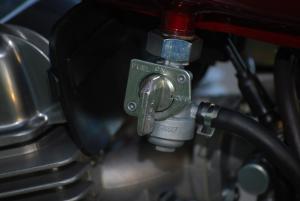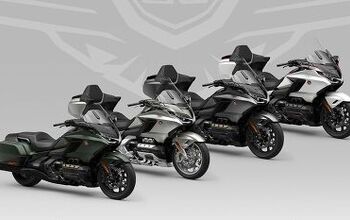2012 Honda Rebel Review - Motorcycle.com
I can’t think of a big-league motorcycle manufacturer that specifically uses the term “beginner bike” as the key selling point to lure new riders. Sure, some might loosely imply as much, but we’ve never seen a “Beginners-Only” tag dangling from a handlebar or in a brochure.
However, if manufacturers had to offer up one bike from their lineup that best defined a beginner’s model, we bet Honda would respond with one word: Rebel.
Although not continuously in Honda’s stable of steel horses every year since its 1985 introduction, the Rebel has become one of those cult symbols of motorcycling – it’s been around seemingly for eons and hasn’t changed significantly in all this time. It’s one of those motorcycles that almost everyone knows about, even if they haven’t ridden one.
A favorite workhorse of motorcycle training and safety courses over the years, this mini-cruiser weighs in at an ultra-manageable 331 pounds with all fluids and a tank full. Its power source is a 234cc (53mm x 53mm), SOHC, four-valve, air-cooled parallel-Twin fed by (are you ready for this?) a constant-velocity (CV) carburetor.
Yes, you read correctly, carbs still exist on current production motorcycles.
The Rebel, she ain’t no speed demon, as you might’ve imagined. It takes what seems like only the blink of an eye to click through the Rebel’s 5-speed gearbox, yet the tiny Twin isn’t overly wheezy. The modest engine is, however, buzzy, especially at lower speeds where most riders will spend the majority of their time. Vibrations eventually smooth out when speeds reach the vicinity of 65 mph, but by that point there isn’t much room left in the Rebel’s power reserves.
This bike cruises dutifully at 70 mph yet she’s only good for another 5 mph or so when WFO. And depending on the grade of the incline you’re ascending, the Rebel’s yell gets a little weak, but not so much as to warrant frantic downshifts in search of sprinting power. Just stay in the throttle and the bike will soldier on. Suffice it to say that the Rebel’s engine, while not grossly underpowered for use on the interstate, is better suited to zipping along surface streets and secondary roads.
With a fuel capacity of 2.6 gallons (and 0.7-gallon reserve) the Rebel will require more frequent trips to the gas station than will its big-bike counterparts. Still, I was more than happy with the 56.6 mpg observed fuel economy, which was achieved mostly while trying to keep pace with traffic in Los Angeles’ sprawling freeway system.
While Honda’s claim of 84 mpg seems optimistic, it’s easy to anticipate that the Rebel could eclipse the above recorded fuel economy by an additional 10 mpg or more when the majority of the miles are on surface streets rather than a high-speed freeway.
Spindly is a fitting description for the appearance of the Rebel’s 33mm Showa fork, but ride quality in front is surprisingly good through its generous 4.6 inches of travel. I came away genuinely impressed by how well damped the fork was for what is presumably budget suspension, even if it succumbs to large expansion joints and potholes that’d give most any bike fits.
The dual coil-over spring shocks with 5-position preload adjustment offer less suspension travel at 2.9 inches, but here again the Rebel’s somewhat low-tech suspension performed admirably. I rode with the shocks set to preload position 2 which never felt under-sprung for my 160-pound frame. And with three more positions available to firm up the ride, the lil’ Rebel should afford heavier riders decent comfort as well.
Considering how briskly the Rebel changes direction, I suspected it weighed less than its 330-pound wet weight. Quick steering inputs aren’t thwarted by a wallowing chassis, but instead the bike remains stable and on track throughout turns. And, man, does this pint-size cruiser ever have some cornering clearance.
Despite its limited rear suspension travel and a lowly 26.6-inch seat height, the Rebel leans with what feels like heaps more clearance than many other cruisers I’ve ridden. The Rebel’s bias-ply Dunlop tires (18-inch front, 15-inch rear) also contribute to the good handling, and I never questioned their grip while darting along curvy roads. Thankfully the front tire’s narrowness, as well as its tread pattern, never caused the front-end to feel as if it was “seeking” on L.A.’s rain-grooved freeways like some other budget bikes with bias-ply tires.
Brake components, like many things on this fundamental motorcycle, are basic: a single disc squeezed by a hydraulically actuated dual-piston sliding-pin caliper in front, and a drum brake in the rear. The front brake is more than up to the task of reeling in the bike, as it has the envious combination of good power and feel, making it easy to modulate. The rear brake is, at best, average and has qualities opposite of the front: stopping force and feel are uninspiring.
You’ll never look at the Rebel and mistake it for a large, ungainly cruiser, yet it also doesn’t look like a ¾-scale motorcycle, either. But within seconds of my first seating, and many times thereafter, the thought that routinely came to mind was, “Geez. This is a small motorcycle.”
With a 30-inch inseam and height of 5 feet 8 inches I’m in the ballpark of the median size rider most manufacturers use when drafting the ergonomic layout of a motorcycle. But the Rebel’s seat-peg-handlebar relationship feels nothing less than cramped. I felt like my elbows were tucked into my ribcage and my knees were squeezing the tank.
The fit for me was as if I sat on a larger cruiser, then pulled the bar, fuel tank and footpegs too closely inward, toward my torso. Nevertheless, I’ve seen riders my size gleefully riding a Rebel 250, so for some folks the physical fit isn’t a deal breaker. Small riders will appreciate its compact, easy-to-manage size.
When earlier I said the Rebel hasn’t changed in a long time, that comment also includes the bike’s price. From Motorcycle.com’s review of a 1996 Rebel we learn the testers felt that at $3999 the Rebel was on the costly side. Wonder what they’d say today if they knew the Rebel’s price increased by less than $200 in 16 years?
Motorcycles comparable to the $4190 Rebel include the 2012 V Star 250 from Star/ Yamaha, with the V-Twin Star’s MSRP matching the Honda dollar for dollar. Suzuki’s GZ250 cruiser (classified as a standard by Suzuki) offers a notable cost savings with its $2999 price. However, it has just a single-cylinder engine and the most current model year available according to Suzuki’s consumer website is a 2010 at the time of this writing. This isn’t inherently bad, just sayin’.
Despite Honda’s willingness to keep the Rebel’s price tag effectively stuck in the 90s, the Rebel and its price create something of dilemma for the rider that’s wavering on which type of street motorcycle to purchase – cruiser or something sportier.
It was just last year that Honda entered the 250cc sportbike class with the CBR250R. The newest and tiniest CBR was generally well-received, and in our 250cc Beginner Bike Shootout the CBR250R managed to beat out the long-running Kawasaki Ninja 250R – the motorcycle that’s dominated the 250cc sportbike class for decades. Then when you consider the CBR250R’s $4099 price is $91 less expensive than the unchanged Rebel, well, you’ve got your dilemma.
Factor in optional $500 ABS for the CBR, and the thoroughly modern, performance-oriented CBR250R seems like it should cost a thousand dollars or more when put next to the aging Rebel. Sure, the CBR uses a single-cylinder engine and is built in Thailand, but we wonder why the long-serving twin-cylinder Rebel costs more than its stablemate. We’d like to see a lower MSRP for the ol’ Rebel, but its continued presence in Honda’s lineup implies that lots of riders see this motorcycle as a heckofa bargain.
If you’ve been eyeing the Rebel for sometime, and having read the above quick comparison still have keen interest in it, you’re probably new to riding and/or short/small-ish in physical stature and have heard lots of good things about the Rebel from the throngs of Rebel enthusiasts. If this is you, heed the Rebel’s yell and check out this classic Honda for yourself.
Related Reading
1996 Honda Rebel Review
2009 250cc Streetbike Shootout
2011 Beginner Bike Shootout
All Things Honda on Motorcycle.com
More by Pete Brissette



































Comments
Join the conversation